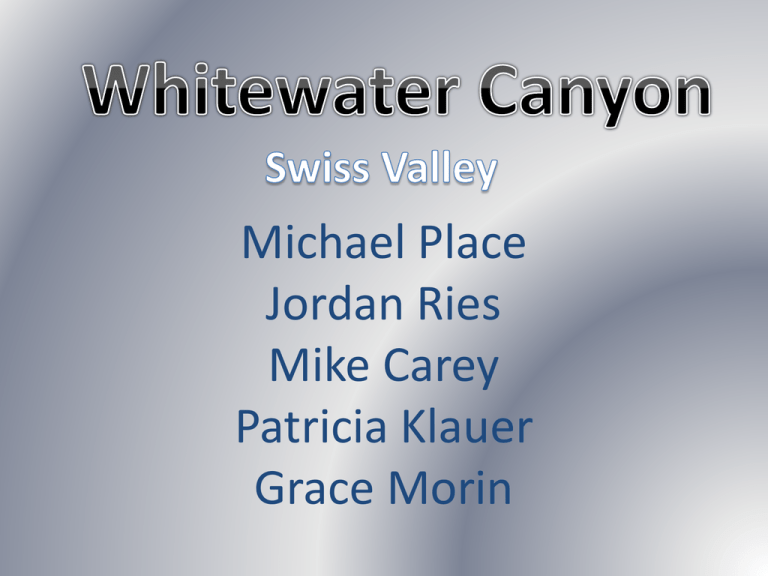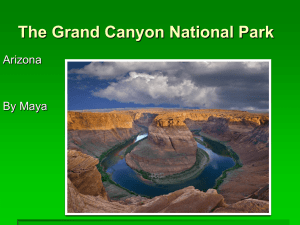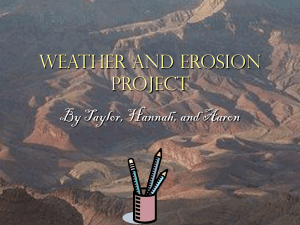Active Learning Artifact
advertisement

Michael Place Jordan Ries Mike Carey Patricia Klauer Grace Morin “This property is extremely unique. There is no development of any kind—and the combination of open land, woodlands and canyon on one property is rare. Whitewater Canyon’s beauty is unsurpassed.” -Bob Walton Director of the Dubuque County Conservation Board •Located in Iowan Surface Region •Situated in southern Dubuque County and northeastern Jones County •419 acre site •The constricted gorge covers 2 miles of straight-line distance •Whitewater Creek opens into the North Fork of Maquoketa River •Is open for public hunting during State designated hunting seasons •Other recreational activities include: hiking, cross country skiing, bird watching, canoeing www.dubuquecounty.org •Formed by glaciers moving through what is now Iowa 500,000 years ago. •30,000-14,000 years ago, silt (loess) and fine sand blew across the region creating a thin topsoil layer. •During that time, the upper Midwest experienced a glacial period, causing accelerated erosion. •This erosion formed Whitewater Canyon. •Once last push of glacial movement occurred only in western and central Iowa, providing the contrast between Iowa landscapes. Prior, Iowa Natural Heritage Foundation Magazine •The previous owners of Whitewater Canyon were Cliff and Jennie Waller. •After 15 years of ownership, they offered the land at a bargain price to the Dubuque County Conservation Board. •They wished the land to remain in its natural state. •DCCB, led by Bob Walton, put together a funding group which included the following: Pheasants Forever Chapters, Whitetail Unlimited Chapters, Wild Turkey Federation, Dubuque Conservation Society, Loras College Environmental Forum, Audubon Society and many private donors. •The purchase agreement was signed by Walton and Waller with the Iowa Natural Heritage Foundation. •INHF held the property while DCCB raised the agreed price of 1 million dollars. •Dick and Arlene Henneberry sold an additional 140 acres, known as the Lost Canyon, to the Jones County Conservation Board. Koch, Unpublished •Founded in 1957 •Led by five County Residents •Headed by Bob Walton •Board members are on a volunteer basis only •Has supervised 2,200 acres of parks, preserves and recreation areas •Supported by County tax funds, user fees, grants and private donations •These parks include: Mines of Spain, E.B. Lyons, Swiss Valley www.dubuquecounty.org “Habitat Today, Pheasants Forever” •Habitat Organization •Building and saving habitats •Protection and enhancement of wildlife populations in North America •Habitat improvement, land management, public awareness and education •Get rid of pastures to restore/reconstruct tallgrass prairies •Has over 115,000 member in 700 local chapters •In 2007, the chapter including Whitewater Canyon won Conservation Chapter of the Year for raising over 1.1 million dollars for expenditure on the land. Interview with Steve Williams who is an active member of Pheasants Forever and assists on work weekends and projects. www.pheasantsforever.org •Is a non-profit conservation group •Founded in 1979 •Celebrating their 30th Anniversary •Includes 7,000 members •Works with private owners and partners to protect land, water and wildlife •Has protected over 100,000 acres of wild •Provides resources for landowners to manage their land for wildlife habitat •Different levels of membership cost different amounts of money (is tax-deductible) www.inhf.org •Prairie restoration was one of the first ecosystems to attempt the process of restoration. •The prairie is a large part of the American Heritage. •Prairies are on the few areas that can handle “experimental restoration”. •Helps determine between reversible and irreversible change •Significant influences on ecosystems are not necessarily the obvious ones •“You can disassemble a thing without knowing much about it, but you can’t put it back together—that is, restore it—without understanding it pretty well. •Questions the modern beliefs of what “nature” and “natural” truly mean. •Hard work is good for the mind, body and soul. Jordan, Foreward Erosion Invasive Species Timber Wildfires Urban Development Recreational Development Preston, Interview •Invasive Species in tallgrass prairies are one of the main issues in dealing with restoration •Any actions common to rural communities, such as plowing, grazing, trampling and the lack of fire, open the pathway for invasive species. •Difficult to fight: 1. Takes time (in years) 2. Chemicals can be harmful to nontarget plants 3. Must burn or “attack” in sections 4. Some species bud from “attacking” methods •Main invasive species at Whitewater Canyon: Garlic Mustard Fought with: fires (in sections) •Seeding (with funding from Pheasants Forever): 1. Indian Tallgrass 2. Big Blue Stem 3. Various trees based on specific area Preston, Interview Solecki 251 1. Pheasants Forever and Diamond Jo Casinos announced Whitewater Canyon as a partial recipient of $7,750: $1,250 will help seed 23 acres of native prairie grass. 2. Main focus is the continual of planting native grasses and the removal of the Garlic Mustard. 3. Gain the highest preserve status from the Iowa Government to insure that no roads, telephone lines will interfere with Whitewater Canyon. 4. Instill a plan to include the community in maintaining and enjoying the natural scenic beauty. 5. Moving in a forward direction (excited about the past direction: third year of public ownership of Whitewater Canyon and better control of timber). Preston, Interview September 29: Astronomy 101/Prairie Hike Begins just before nightfall at Hartman Reserve and ends with star gazing at Cedar Hills Sand Prairie September 30: Maharishi/Vedic City Tour Explores solar and wind power with the Maharishi University of Management. Tours Abundance Ecovillage and eats a organic buffet luncheon. Past events included: Family Fun Bike Ride A-mazing Prairie Festival Habitat Movie Night Scaly and Slimy (a live reptile program) www.mycountyparks.com Most scholarships limited to high school seniors, those choosing a specific field of study or a particular university. Dubuque County Conservation Board: •Provides summer camps with cost covered Pheasants Forever: •Depends on the Chapter of Pheasants Forever •Give 15 scholarships per year •1/3 of budget is given for educational camps •Outdoor Journey for Girls (ages 12-15) •Hunting and Conservation Camp (ages 12-15) Iowa National Heritage Foundation: •Paid internships offered to college students (Land stewardship, communications, graphic design, program support/grant writing) www.dubuquecounty.org www.inhf.org www.pheasantsforever.org








